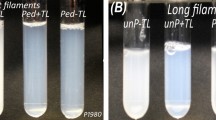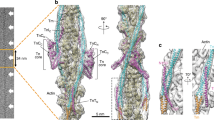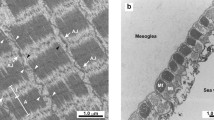Abstract
Using electron microscopy and negative staining we have studied the effect of Ca2+ on the structure of synthetic filaments of chicken gizzard smooth muscle myosin under conditions applied by Frado and Craig (1989) for demonstration of the influence of Ca2+ on the structure of synthetic filaments of scallop striated muscle myosin. The results show that Ca2+ induces the transition of compact, ordered structure of filaments with a 14.5 nm axial repeat of the myosin heads close to the filament backbone (characteristic of the relaxing conditions) to a disordered structure with randomly arranged myosin heads together with subfragments-2 (S-2) seen at a distance of up to 50 nm from the filament backbone. This order/disorder transition is much more pronounced in filaments formed of unphosphorylated myosin, since a substantial fraction of phosphorylated filaments in the relaxing solution is already disordered due to phosphorylation. Under rigor conditions some of the filaments of unphosphorylated and phosphorylated myosin retain a certain degree of order resembling those under relaxing conditions, while most of them have a substantially disordered appearance. The results indicate that Ca2+-induced movement of myosin heads away from the filament backbone is an inherent property of smooth muscle myosin, like molluscan muscle myosin regulated exclusively by Ca2+ binding, and can play a modulatory role in smooth muscle contraction.
Similar content being viewed by others
References
Allen BG and Walsh MP (1994) The biochemical basis of the regulation of smooth muscle contraction. Trends BiochemSci 19: 362–368.
Barsotti RJ, Ikebe Mand, Hartshorne DJ (1987) Effects of Ca2., Mg2. and myosin phosphorylation on skinned smooth muscle fibers. Am J Physiol 252: C543–554.
Chalovich JM and Pfitzer G (1997) Structure and function of the thin filament proteins of smooth muscle. In: Kao CY and Carsten ME (teds). Cellular Aspects of Smooth Muscle Function (pp.253–286). Cambridge University Press, Cambridge, UK.
Clarke ML, Hofmann W and Wray JS (1986) ATP binding and crossbridge structure in muscle. J Mol Biol 191: 581–585.
Cooke PH, Fay FS and Craig R (1989) Myosin filaments isolated from skinned amphibian smooth muscle cells are side–polar. J Muscle Res Cell Motil 10: 206–220.
Craig R, Padron R and Kendrick–Jones J (1987) Structural changes accompanying phosphorylation of tarantula muscle myosin filaments. J Cell Biol 184: 429–443.
Da Silva ACR and Reinach FC (1991) Calcium binding induces conformational changes in muscle regulatory proteins. Trends Biochem Sci 16: 53–57.
Da Silva ACR, Kendrick–Jones J and Reinach FC (1995) Determinants of ion specificity on EF–hands sites. J Biol Chem 270: 67736778.
Dąbrowska R (1994) Actin and thin filament–associated proteins in smooth muscle. In: Raeburn D and Giembycz MA (eds). Airways Smooth Muscle: Biochemical Control of Contraction and Relaxation (pp. 31–59). Birkhäuser Verlag, Basel.
Diffee GM, Greaser ML, Reinach FC and Moss RL (1995) Effects of non–divalent cation binding mutant of myosin regulatory light chain on tension generation in skinned skeletal muscle fibers. Biophys J 68: 1443–1452.
Diffee GM, Patel JR, Reinach FC, Greaser ML and Moss RL (1996) Altered kinetics of contraction in skeletal muscle fibers containing a mutant myosin regulatory light chain with reduced divalent cation binding. Biophys J 71: 341–350.
Ebashi S (1991) Excitation–contraction coupling and the mechanism of muscle contraction. Annu Rev Physiol 53: 1–16.
Farah CS and Reinach FC (1995) The troponin complex and regulation of muscle contraction. FASEB J 9: 755–776.
Frado L–LY and Craig RJ (1989) Structural changes induced in Ca2.regulated myosin filaments by Ca2. and ATP. J Cell Biol 109: 529–538.
Hai CM and Murphy RA (1989) Ca2., crossbridge phosphorylation, and contraction. Annu Rev Physiol 51: 285–298.
Hartshorne DJ and Kawamura T (1992) The biochemical basis of the regulation of smooth muscle contraction. News Physiol Sci 7: 59–63.
Heaslip RJ and Chacko S (1985) Effects of Ca2. and Mg2. on the actomyosin adenosine–50–triphosphatase of stably phosphorylated gizzard myosin. Biochemistry 24: 2731–2736.
Holroyde MJ, Potter JD and Solaro RJ (1979) The calcium binding properties of phosphorylated and unphosphorylated cardiac and skeletal myosins. J Biol Chem 254: 6478–6482.
Ikebe M and Hartshorne DJ (1985)Effects of Ca2. on the conformation and enzymatic activity of smooth muscle myosin. J Biol Chem 260: 13146–13153.
Ikebe M and Ogihara S (1982) Phosphorylation–dependent and ATPinduced changes in structural array in gizzard myosin filament bundles. J Biochem (Tokyo) 92: 1973–1977.
Jakes R, Northrop F and Kendrick–Jones J (1976) Calcium binding regions of myosin regulatory light chains. FEBS Lett 70: 229–232.
Kamm KE and Stull JT (1985) The function of myosin and myosin light chain kinase phosphorylation in smooth muscle. Annu Rev Pharmacol Toxicol 25: 593–620.
Knight PJ (1996) Dynamic behavior of the head–tail junction of myosin. J Mol Biol 255: 269–274.
Kulikova N and Dąbrowska R (1996) The influence of caldesmon on papain proteolysis of monomeric smooth muscle myosin. Biochem Biophys Res Commun 225: 195–202.
Laemmli UK (1970) Cleavage of structural proteins during the assembly of the head of bacteriophage T4. Nature 227: 680–685.
Levine RJC (1997) Differences in myosin head arrangement on relaxed thick filaments from Lethocerus and rabbit muscles. J Muscle Res Cell Motil 18: 529–543.
Levine RJC, Kensler RW, Yang Z, Stull JT and Sweeney HL (1996) Myosin light chain phosphorylation affects the structure of rabbit skeletal muscle thick filaments. Biophys J 71: 898–907.
Levine RJC, Yang Z, Epstein ND, Fananapazir L, Stull JT and Sweeney HL (1998) Structural and functional responses of mammalian thick filaments to alterations in myosin regulatory light chains. J Struct Biol 122: 149–161.
Lowey S and Risby D (1971) Light chains from fast and slow muscle myosin. Nature 234: 81–85.
Marston SB and Redwood CS (1991) The molecular anatomy of caldesmon. Biochem J 279: 1–16.
Méenéetret J–P, Hofmann W and Lepault J (1988) Cryo–electron microscopy of insect flight muscle thick filaments. An approach to dynamic electron microscope studies. J Mol Biol 202: 175–178.
Morris EP, Squire JM and Fuller GW (1991) The 4–stranded arrangement of myosin heads on insects (Lethocerus) flight muscle thick filaments. J Struct Biol 107: 237–249.
Moss RL (1992) Ca2. regulation of mechanical properties of striated muscle. Mechanistic studies using extraction and replacement of regulatory proteins. Circ Res 70: 865–884.
Notarianni G, Collins J, Leszyk J and Marston SB (1998) A novel Ca2.–binding protein associated with caldesmon in smooth muscle thin filaments. J Muscle Res Cell Motil 19: 311.
Podlubnaya Z, Stępkowski D, Udaltsov SN and Kąkol I (1994) Attachment–detachment behavior of crossbridges on the surface of reconstituted myosin filaments: effect of pH, Ca–ions and myosin light chains phosphorylation. J Muscle Res Cell Motil 15: 203.
Podlubnaya Z, Kąkol I, Moczarska A and Stępkowski D (1996) Structural behavior of crossbridges in reconstituted rabbit cardiac myosin filaments: effect of pH–value and Ca2.–level. J Muscle Res Cell Motil 17: 117.
Podlubnaya Z, Kulikova N and Dąbrowska R (1999) Ca2.–binding to smooth muscle myosin changes the structure and enzymatic properties of its reconstituted filaments. J Muscle Res Cell Motil. 20: 81–82.
Rayment I, Rypniewski WR, Schmidt–Bäse K, Smith R, Tomchick DR, Benning MM, Winkelmann DA, Wesenberg G and Holden HM (1993) Three–dimensional structure of myosin subfragment–1: a molecular motor. Science 261: 50–58.
Rees DD and Frederiksen DW (1981) Calcium regulation of porcine aortic myosin. J Biol Chem 256: 357–364.
Siegman MJ, Butler TM, Mooers SU and Michaøek A (1984) Ca2. can affect Vmax without changes in myosin light chain phosphorylation in smooth muscle. PfluÈgers Arch 401: 385–390.
Sobieszek A (1994) Smooth muscle myosin: molecule conformation, filament assembly and associated regulatory enzymes. In: Raeburn D and Giembycz MA (eds). Airways Smooth Muscle: Biochemical Control of Contraction and Relaxation (pp. 1–29). Birkhäuser Verlag, Basel.
Sobieszek A (1985) Phosphorylation reaction of vertebrate smooth muscle myosin: an enzyme kinetic analysis. Biochemistry 24: 12661274.
Sobieszek A and Jertschin P (1986) Urea–glycerol–acrylamide gel electrophoresis of acidic low molecular weight muscle proteins: rapid determination of myosin light chain phosphorylation in myosin, actomyosin and whole muscle samples. Electrophoresis 7: 417–425.
Somlyo AP and Somlyo AV (1994) Signal transduction and regulation in smooth muscle. Nature 372: 231–236.
Squire JM and Morris EP (1998) A new look at thin filament regulation in vertebrate skeletal muscle. FASEB J 12: 761–771.
Stępkowski D, Efimova N, Paczyńska A, Moczarska A, Nieznańska H and Kąkol I (1997) The possible role of myosin A1 light chain in the weakening of actin–myosin interaction. Biochim Biophys Acta 1340: 105–114.
Strynadka NCJ and James MNG (1989) Crystal structures of the helix–loop–helix calcium–binding proteins. Annu Rev Biochem 58: 951–998.
Swartz DR, Moss RL and Greaser ML (1996) Calcium alone does not fully activate the thin filament for S1 binding to rigor myofibrils. Biophys J 71: 1891–1904.
Sweeney HL, Browman BF and Stull JT (1993) Myosin light chain phosphorylation in vertebrate striated muscle: regulation and function. Am J Physiol 264: C1085–C1095.
Szczęsna D, Zhao J and Potter JD (1996) The regulatory light chains of myosin modulate cross–bridge cycling in skeletal muscle. J Biol Chem 271: 5246–5250.
Szczęsna D, Zhao J, Roman N, Zhi G, Stull J and Potter J (1997) Phosphorylation and Ca2. binding to the regulatory light chains of myosin modulate force development in skeletal muscle. Conference `A Myosin Family Reunion: Biology to Pathology', Bethesda, MD Abstract F–26.
Trybus KM (1994) Role of myosin light chains. J Muscle Res Cell Motil 15: 587–594.
Trybus KM, Freyzon Y, Faust LZ and Sweeney HL (1997) Spare the rod, spoil the regulation: necessity for a myosin rod. Proc Natl Acad Sci USA 94: 48–52.
Trybus KM and Lowey S (1988) The regulatory light chain is required for folding of smooth muscle myosin. J Biol Chem 263: 1648516492.
Vibert P and Craig R (1985) Structural changes that occur in scallop myosin filaments upon activation. J Cell Biol 101: 830–837.
Watterson JG, Kohler L and Schaub M (1979) Evidence for two distinct anities in the binding of divalent metal ions to myosin. J Biol Chem 254: 6470–6477.
Xie X, Harrison DH, Schlichting I, Sweet RM, Kalabokis VN, SzentGyórgyi AG and Cohen C (1994) Structure of the regulatory domain of scallop myosin at 2.8 A Ê resolution. Nature 368: 306–312.
Xu J–Q, Harder BA, Uman P and Craig R (1996) Myosin filament structure in vertebrate smooth muscle. J Cell Biol 134: 53–66.
Yang Z, Stull JT, Levine RJC and Sweeney HL (1998)Changes in interfilament spacing mimic the effects of myosin regulatory light chain phosphorylation in rabbit psoas fibers. J Struct Biol 122: 139–148. 554
Author information
Authors and Affiliations
Rights and permissions
About this article
Cite this article
Podlubnaya, Z., Kulikova, N. & Dąbrowska, R. The effect of Ca2+ on the structure of synthetic filaments of smooth muscle myosin. J Muscle Res Cell Motil 20, 547–554 (1999). https://doi.org/10.1023/A:1005533020784
Issue Date:
DOI: https://doi.org/10.1023/A:1005533020784




